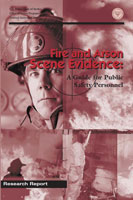|
View in browser: http://www.crime-scene-investigator.net/newsletter/0217.html
|
||
|
February 2017 | ||
|
Welcome to the February 2017 Crime Scene Investigator Network Newsletter
| ||
|
This Month's Featured Resource on the Crime Scene Investigator Network Website
|
||
 It is the intention of this Guide to acquaint a broad spectrum of public safety personnel with the fire investigation process, so they may understand their role in this important task and help identify, locate, and preserve evidence in its varied forms, to either assist a specialist investigator when one is needed or to adequately document and collect evidence when no assistance is needed or available. This Guide focuses on the documentation and collection of physical evidence at fire/arson scenes. <View the Publication> |
||
|
New CSI and Forensic Job Announcements
|
||
|
The most comprehensive listing of Crime Scene Investigation and Forensic To be notified of job openings as they are posted, follow us on Twitter: Job Posting Alerts |
||
|
Crime Scene Specialist
Travis County Sheriff'S Department, Austin, Texas, USA Final Filing Date: March 7, 2017 Under general supervision, performs technical and scene processing support for countywide crime scenes by photographing and sketching physical evidence, processing evidence and marking/packaging physical evidence, such as finger/shoe prints and collection of biologicals to satisfy legal and scientific requirements. Prepares reports of findings, testifies in a court at law about work performed and deposition of all physical evidence. <View complete job listing> |
||
|
Forensic Scientist - Digital Evidence
Kansas Bureau of Investigation, Topeka, Kansas, USA Final Filing Date: March 6, 2017 Preforms examinations on digital evidence - this includes taking actions to recover, preserve, and analyze data from electronic sources, including desktop and laptop computers, mobile devices, removable media, and other items deemed necessary. <View complete job listing> |
||
|
Forensic Firearms and Toolmark Examiner
Dallas Police Department, Dallas, Texas, USA Final Filing Date: March 4, 2017 Perform a variety of analysis on bullets, cartridge casings, firearms and other related physical evidence. Prepare a written analysis of the findings and present the findings in court. <View complete job listing> |
||
 |
||
|
Latent Fingerprint Examiner
Miami-Dade Police Department, Doral, Florida, USA Final Filing Date: March 6, 2017 Employees in this class are responsible for identifying fingerprints, preparing court exhibits, and providing testimony in courts of law. Duties include utilization of an Automated Fingerprint Identification System (AFIS), performing latent chemical processes on items of physical evidence, providing latent identification services for other jurisdictions, and reviewing and verifying latent print identifications. <View complete job listing> |
||
|
Sheriff Services Technician - Evidence
Larimer County Sheriff's Office, Fort Collins, Colorado, USA Final Filing Date: March 8, 2017 This position receives, stores, returns or disposes all property, evidence, and found property according to policy and procedure. <View complete job listing> |
||
|
Coroner Investigator Trainee
County of Los Angeles Department of Medical Examiner - Coroner, Los Angeles, California, USA Final Filing Date: March 1, 2017 Participates in a basic specialized coroner's investigator training program in accordance with the California Commission on Peace Officer Standards and Training (P.O.S.T.) and Departmental guidelines and policies. <View complete job listing> |
||
|
Search for more job listings in Crime Scene Investigations and Forensics To be notified of job openings as they are posted, follow us on Twitter: Job Posting Alerts |
||
|
Other Resources on the Crime Scene Investigator Network Website
|
||
|
Crime Scene Investigator mdash; Blog
Crime Scene Investigator Forum How to Become a Crime Scene Investigator Crime Scene Response Evidence Collection Crime Scene and Evidence Photography Crime Scene Investigation Articles Video Presentations Training and Colleges Employment Bookstore Resources and Links |
||
|
Not Subscribed to this Newsletter?
|
||
|
If you are not subscribed to this newsletter, you may subscribe with this link: SUBSCRIBE via email |
||
|
To Unsubscribe
|
||
|
To unsubscribe from future e-mail newsletters, please click here: UNSUBSCRIBE Copyright ©2017 Crime Scene Resources, Inc. Crime Scene Investigator Network |


